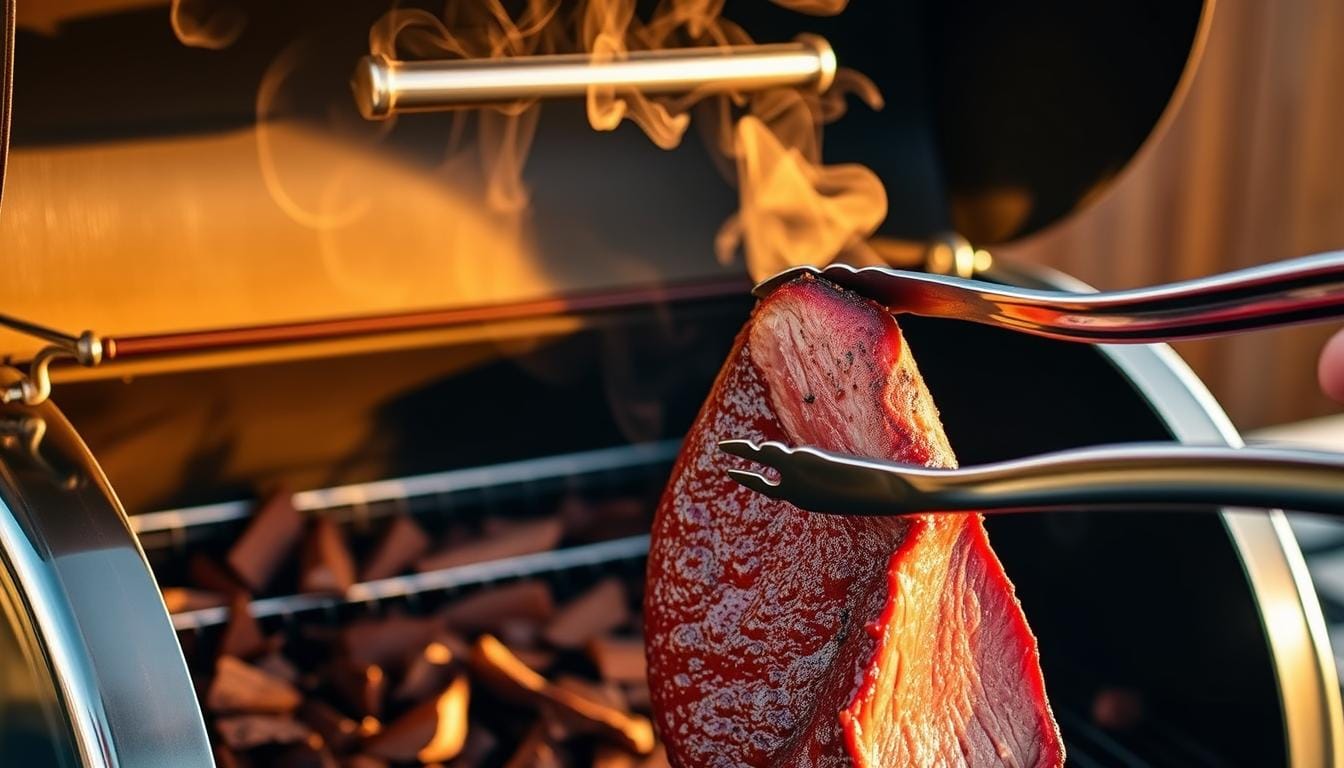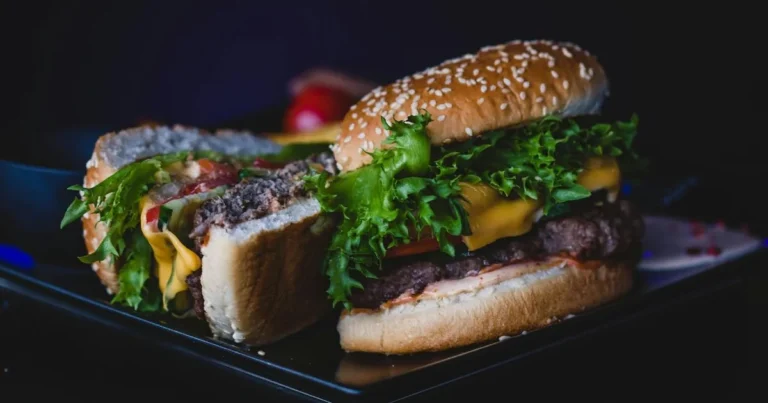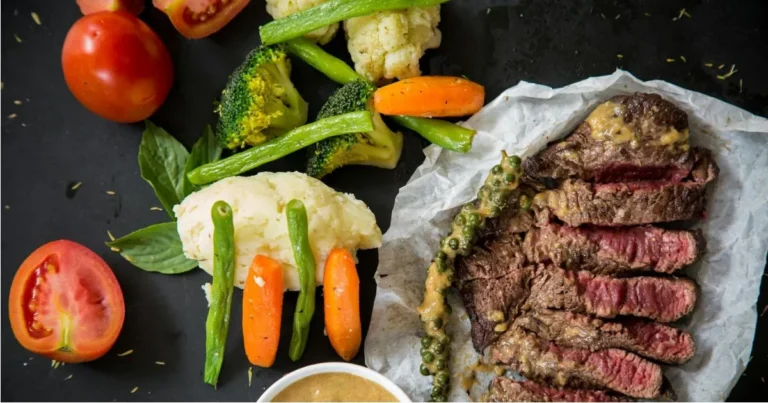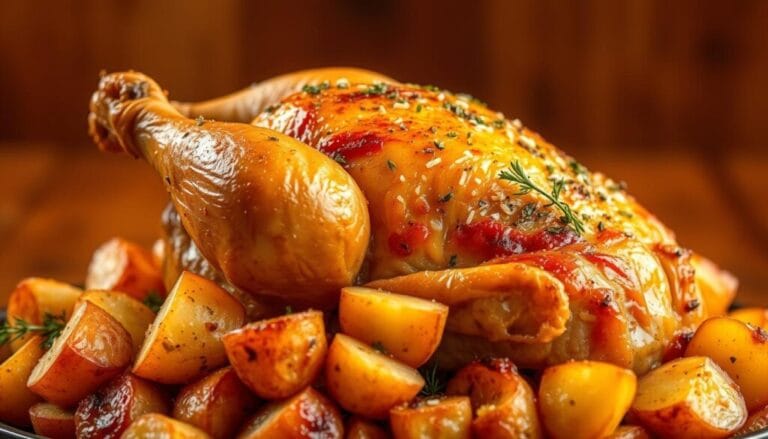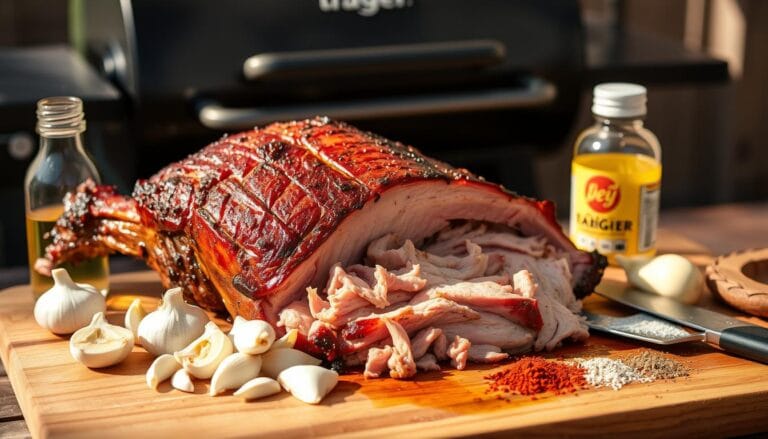Easy Brisket Traeger-5 Foolproof Ways to Smoke
Table of Contents
Easy Brisket Traeger
Imagine a crisp weekend morning with the smell of smoky beef in the air. Your Traeger grill is ready to turn a simple cut of meat into a legendary dish. Smoking a brisket is more than cooking—it’s an art that connects us to BBQ legends.
Your Traeger brisket recipe will be the highlight of every backyard party. Whether you’re an experienced pitmaster or just starting, learning to smoke brisket will take your grilling to the next level. We’ll show you how to pick the right cut and master the art of low and slow cooking.
Smoking brisket on a Traeger is a celebration of flavor, patience, and skill. Get ready to discover the secrets that will make your brisket the main attraction at every meal.
Key Takeaways
- Traeger grills offer consistent temperature control for perfect brisket
- Proper preparation is crucial for mouthwatering results
- Understanding internal temperature is key to tender meat
- Patience and technique matter more than expensive equipment
- Wood pellet selection dramatically impacts overall flavor
Why Choose Traeger for Smoking Brisket?
Choosing the right grill is key to making the best traeger brisket. Traeger pellet grills have changed home barbecue. They offer unmatched precision and flavor for smoking meats.
Smoking brisket with a Traeger is a mix of tech and cooking art. These grills offer several benefits that boost your BBQ skills:
- Consistent temperature control
- Wide range of wood pellet flavors
- Easy-to-use digital controls
- Versatile cooking capabilities
Benefits of Pellet Grills
Pellet grills offer unique perks for home cooking. They use wood pellets for clean, consistent heat and great flavor. The Traeger Grills Pro 22 lets you grill, smoke, bake, roast, braise, and BBQ easily.
Consistent Temperature Control
When smoking brisket, precision is crucial. Traeger grills keep temperatures between 225°F and 250°F. This ensures your meat cooks evenly. The digital controller makes it easy, so you can focus on making mouthwatering food.
Flavor Options with Wood Pellets
Wood pellets offer different flavors. You can try hickory to mesquite with Royal Oak Charcoal Hardwood Pellets. This lets you tailor your brisket’s taste with each cook.
Pro tip: A 2:1 ratio of Meat Church Holy Cow to Holy Gospel seasoning can enhance your brisket’s flavor when using a Traeger grill.
Selecting the Perfect Brisket Cut
Choosing the right brisket is key for a great Traeger brisket experience. The cut you pick affects the flavor, tenderness, and quality of your smoked meat. Knowing the different cuts and grades helps you make a smart choice.
Whole Brisket vs. Flat or Point Cut
When picking a brisket for your Traeger, you have three main options:
- Whole Packer Brisket: Includes both point and flat sections, ideal for experienced smokers
- Flat Cut: Leaner section, perfect for uniform slicing
- Point Cut: More marbled and flavorful, great for burnt ends
USDA Grades Explained
Beef grades greatly affect your traeger brisket rub and meat quality. The three main grades are:
- Prime: Highest quality with exceptional marbling
- Choice: Good marbling, more affordable
- Select: Leaner, less tender cut
Recommended Size for Smoking
For the best traeger brisket time and temp, follow these guidelines:
- Average brisket weight: 12-15 pounds
- Cooking time: Approximately 12-14 hours
- Ideal internal temperature: 202°F
Pro tip: Look for briskets with consistent marbling and a fat cap around 1/4 inch thick for the best smoking results.
Essential Brisket Preparation Steps
Preparing a brisket for your Traeger pellet grill needs careful attention. The right steps can turn a simple cut of meat into a delicious masterpiece. This will impress even the pickiest BBQ fans.
Trimming the Brisket Correctly
Proper trimming is key for a great traeger pellet grill brisket. Follow these important steps:
- Remove excess hard fat and silver skin
- Leave about ⅛-¼ inch of fat cap for moisture
- Square the edges for even cooking
- Aim for a clean, uniform shape
Applying a Flavorful Rub
A great brisket rub can make your traeger brisket cook time amazing. Here are some rub tips:
- Use a lot of seasoning
- Mix kosher salt and coarse black pepper
- Apply rub 24 hours before cooking
- Make sure to cover all surfaces evenly
Marinating or Injecting for Maximum Flavor
To boost moisture and taste, you can marinate or inject:
- Marinating: Soak brisket in liquid seasonings for 4-12 hours
- Injecting: Use a meat injector to add flavor deep into the meat
- Beef broth is great for injections
- Adding worcestershire sauce or apple juice can add depth
Pro tip: Let your seasoned brisket rest in the fridge overnight. This lets flavors soak in deeply.
Setting Up Your Traeger Grill
Getting your Traeger ready for a brisket recipe is key. The right setup can turn a good brisket into an amazing one.
Assembling Your Grill and Accessories
Before starting, make sure your grill is set up right. You’ll need a few things:
- Meat thermometer
- Drip pan
- Aluminum foil
- Heat-resistant gloves

Choosing the Right Wood Pellets
Wood pellets add flavor to your brisket. Pick ones that match beef’s deep taste.
| Wood Type | Flavor Profile | Best For Brisket |
|---|---|---|
| Hickory | Strong, bacon-like | Excellent |
| Oak | Medium, classic BBQ | Very Good |
| Mesquite | Intense, earthy | Good |
Preheating and Temperature Settings
For a great brisket, precision is crucial. Heat your Traeger to 225°F. This is the best temperature for slow-smoking.
Use a remote thermometer with two probes. This lets you check both the smoker and meat temperatures.
“Low and slow is the golden rule for perfect brisket” – BBQ Pitmaster
Remember, the weather can change your grill’s temperature. In summer, it might get up to 475°F. In winter, it could drop to 400°F. Always keep an eye on it and adjust as needed.
The Smoking Process Explained
Smoking a brisket on a Traeger grill is an art that needs patience and precision. The best Traeger brisket comes from knowing the smoking process. This process turns a tough cut of meat into a tender, flavorful masterpiece.
Your smoked brisket Traeger journey involves watching temperature and time closely. The smoking process usually takes between 12-18 hours, depending on your brisket’s size.
Smoking Time Estimates
When planning your brisket smoke, keep these timing guidelines in mind:
- Average cooking time: 1 to 1.25 hours per pound
- Total process time: 20-24 hours (including preparation)
- Actual smoking time: 5-7 hours for average-sized brisket
Monitoring Internal Temperature
Tracking temperature is key for the perfect brisket. Important temperature milestones include:
- Stall point: Around 150-160°F
- Wrapping temperature: Approximately 170°F
- Final target temperature: 195-205°F
Using a Meat Thermometer
A reliable meat thermometer is your best tool for ensuring perfectly smoked brisket. Insert the probe into the thickest part of the meat, avoiding fat pockets. Check temperature regularly to track progress and prevent overcooking.
Pro tip: The key to a great brisket is patience and consistent temperature monitoring.
Techniques for Perfect Bark
Creating the ultimate brisket bark is an art form. It’s what makes great barbecue stand out. Your Traeger brisket rub is key to that crispy exterior everyone loves. To master bark development, you need to know some techniques and how to manage temperature.
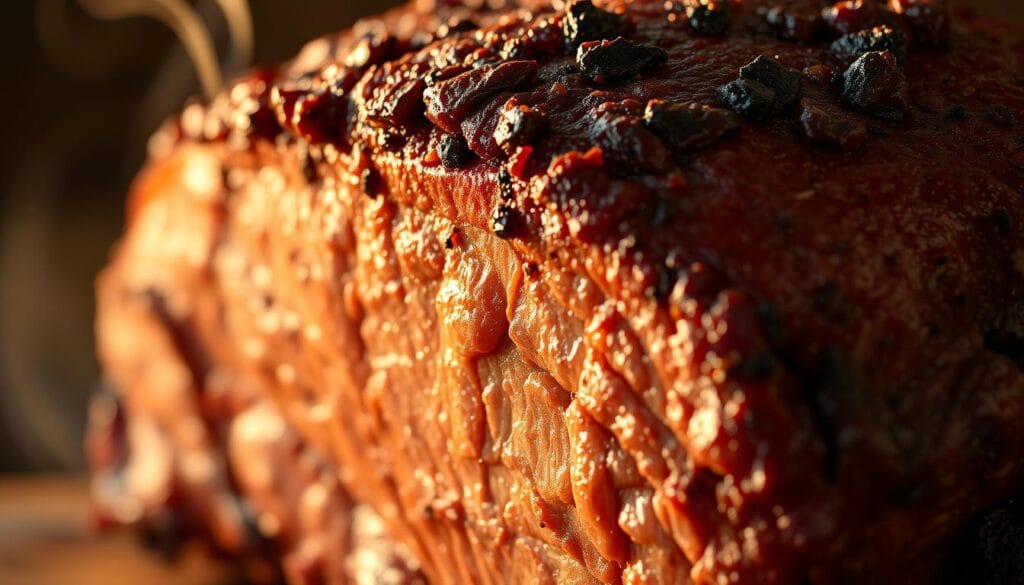
Moisture Management Strategies
When smoking brisket, controlling moisture is crucial. You have two main methods to try:
- Spritzing: Lightly spray the brisket with liquid every hour
- Water Pan Method: Place a pan of water in the smoker to keep humidity up
Wrapping for Bark Protection
Wrapping your brisket can greatly affect bark quality. Here are some tips for your Traeger brisket time and temp plan:
- Wait until the internal temperature hits 190℉
- Use butcher paper instead of foil for better bark retention
- Wrap snugly but not too tightly to let smoke circulate
Developing a Crunchy Bark
To get a perfect bark, focus on these:
- Apply a generous traeger brisket rub with coarse ingredients
- Keep the smoker temperature steady
- Stay away from too much moisture during cooking
Pro tip: Let the bark develop naturally by minimizing intervention during the smoking process.
Resting and Slicing the Brisket
After smoking your traeger pellet grill brisket, the final steps are crucial. They help achieve maximum flavor and tenderness. Proper resting and slicing can turn a good brisket into an extraordinary dish.
Why Resting Is Essential
Resting your brisket is a key step in the cooking process. It lets the meat’s juices spread evenly. This makes each slice moist and full of flavor. Experts say to let the brisket rest for 2-3 hours after it’s done smoking.
- Allows juices to redistribute throughout the meat
- Prevents moisture loss during cutting
- Enhances overall tenderness and flavor
Best Practices for Slicing
Slicing a brisket needs precision and technique. Use a sharp 10-12 inch knife to cut against the grain. This makes the meat tender and easy to bite.
| Slicing Technique | Recommended Approach |
|---|---|
| Slice Thickness | ¼ inch |
| Cutting Direction | Against the grain |
| Knife Length | 10-12 inches |
Serving Suggestions
Present your brisket on a large cutting board. This lets guests see the beautiful bark and juicy inside. Serve it with classic barbecue sides like coleslaw, baked beans, or cornbread for a full meal.
Pro tip: Keep leftover brisket moist by storing it with its own cooking juices.
Common Mistakes to Avoid
Smoking a perfect brisket on a Traeger needs precision and focus. Many home chefs make mistakes that can ruin a great brisket. Knowing these common errors can help you improve your barbecue skills and make a delicious brisket every time.
Overcooking and Undercooking Challenges
The difference between a great brisket and a tough piece of meat is small. Your technique must be about keeping the temperature just right. If you overcook, the meat gets dry and tough. If you undercook, it’s chewy and not safe to eat.
- Overcooking signs:
- Meat becomes dry and stringy
- Loses its rich, tender texture
- Flavor becomes bland and flat
- Undercooking indicators:
- Tough, chewy meat
- Lack of proper internal breakdown
- Potential food safety risks
Temperature Guidelines and Seasoning Secrets
Internal temperature is key when smoking brisket. Traeger brisket recipe success depends on hitting the sweet spot of 202 degrees Fahrenheit. Without proper seasoning, a great dish can turn bland.
| Mistake | Consequence | Solution |
|---|---|---|
| Ignoring Internal Temp | Inconsistent Cooking | Use Meat Thermometer |
| Insufficient Seasoning | Lack of Flavor | Apply Robust Dry Rub |
| Improper Resting | Dry Meat | Rest 30-60 Minutes |
Mastering your Traeger brisket recipe is a journey of patience and practice. Each smoke teaches you something new about managing temperature, moisture, and flavor.
Creative Ways to Enjoy Smoked Brisket
Once you’ve perfected the best Traeger brisket recipe, you’ll want to try new things with your leftover meat. Smoked brisket is incredibly versatile, offering endless possibilities beyond just slicing it.
Think about using your brisket in tacos, loaded nachos, or as gourmet pizza toppings. These ideas can turn your meat into something truly special. Shred the brisket and add it to crispy tortillas with fresh salsa, or top homemade pizza for a smoky flavor that will wow your guests.
Fusion Dishes and Comfort Food
Try using your brisket in potato bombs or hearty sandwiches for another tasty option. Stuff baked potatoes with the tender meat or make loaded brisket sandwiches for a lunch that’s sure to please. The goal is to bring out the rich flavors you’ve worked hard to achieve, making every bite a delight.
Versatile Meal Solutions
Remember, your smoked brisket can be kept in the fridge for up to 4 days or frozen for 4 months. This gives you lots of time to try out different recipes. Use it in salads, mix it into chili, or create your own BBQ-inspired dishes. Your Traeger-smoked brisket is a treasure waiting to be explored.

